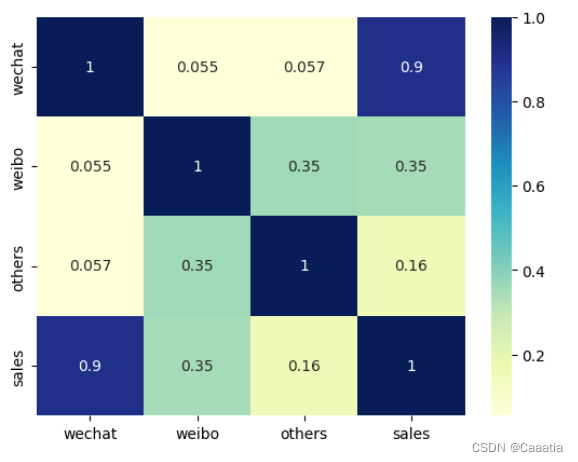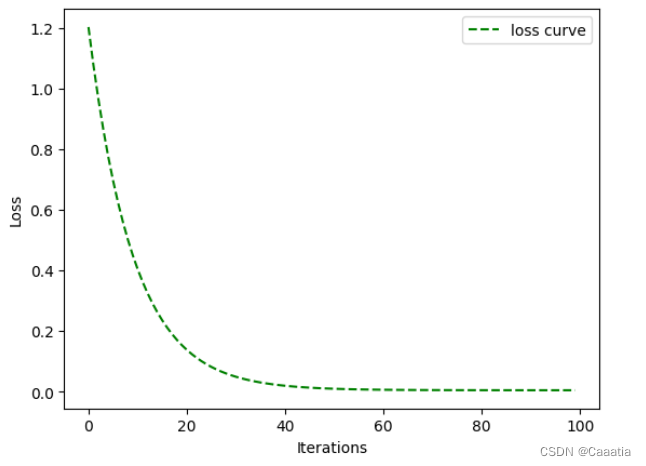载入数据并可视化
# load data
import pandas as pd
import numpy as np
import matplotlib.pyplot as plt
import seaborn as sns
df_all = pd.read_csv('/kaggle/input/advertising-simple-dataset/advertising.csv')
# virual the data
# 相关性热力图
sns.heatmap(df_all.corr(), cmap='YlGnBu', annot=True)
plt.show()
# visual (scatter plot)
sns.pairplot(df_all,
x_vars=['wechat', 'weibo', 'others'],
y_vars='sales',
height=4, aspect=1, kind='scatter')
plt.show()

明显观测到微信广告投放量与营业额关联度最高,因此先仅考虑wechat这一维度 特征。
数据处理
特征选择
# 因为weibo和others与销售额的相关度不大,所以暂时忽略这两个数据列,构造数据特征和标签
x = np.array(df_all.wechat)
y = np.array(df_all.sales)
# linear regression 模型可接受的输入应该是二维矩阵
# reshape 1D to 2D
x = x.reshape((len(x), 1))
y = y.reshape((len(y), 1))训练集和测试集拆分
# 训练集和测试集的拆分
from sklearn.model_selection import train_test_split
x_train, x_test, y_train, y_test = train_test_split(x, y, test_size=0.2, random_state=0)数据归一化
# 数据归一化
# 函数定义
def scaler(train, test):
min = train.min(axis=0)
max = train.max(axis=0)
gap = max - min
train -= min
train /= gap
test -= min
test /= gap
return train, test
x_train, x_test = scaler(x_train, x_test)
y_train, y_test = scaler(y_train, y_test)
# 对归一化的数据进行可视化
plt.plot(x_train, y_train, 'r*', label='Training data')
plt.xlabel('wechat')
plt.ylabel('sales')
plt.legend()
plt.show()
模型构建
损失函数
# 定义一个均方差损失函数
def loss_function(x, y, weight, bias):
y_hat = weight * x + bias
loss = y_hat - y
cost = np.sum(loss**2)/(2*len(x))
return cost梯度下降
# 自定义梯度下降函数
def gradient_descent(x, y, w, b, lr, iters):
l_history = np.zeros(iters) # 初始化记录梯度下降cost的数组
w_history = np.zeros(iters) # 初始化记录历史w的数组
b_history = np.zeros(iters) # 初始化记录历史b的数组
for i in range(iters):
y_hat = x * w + b # 这是假设函数
loss = y_hat - y # 这是中间过程的loss
derivative_w = x.T.dot(loss)/len(x) # 对w求导
derivative_b = sum(loss) * 1/len(x) # 对b求导
w = w - lr * derivative_w # 更新w
b = b - lr * derivative_b # 更新b
l_history[i] = loss_function(x, y, w, b) # 记录第i次循环时候的cost
w_history[i] = w # 记录第i次循环时候的w
b_history[i] = b # 记录第i次循环时候的b
return l_history, w_history, b_history
模型训练
初始化
# 随机给一个初始的权重和偏置
iterations = 100
alpha = 1
weight = -5
bias = 3
# 计算当前的cost
print("当前的假设函数带来的损失:", loss_function(x_train, y_train, weight, bias))训练
alpha = 0.8
l_history, w_history, b_history = gradient_descent(x_train, y_train, weight, bias, alpha, iterations)可视化
# 可视化loss曲线
plt.plot(l_history, 'g--', label = 'loss curve')
plt.xlabel('Iterations')
plt.ylabel('Loss')
plt.legend()
plt.show()
print('当前损失:', l_history[-1])
print("当前偏置:", w_history[-1])
print("当前偏置:", b_history[-1])当前损失: 0.004679247434449546 当前偏置: 0.637595842244559 当前偏置: 0.18593650852725271
# 在测试集上进行预测
print("", loss_function(x_test, y_test, w_history[-1], b_history[-1]))0.004751209278505268
相关公式待补全





















 990
990

 被折叠的 条评论
为什么被折叠?
被折叠的 条评论
为什么被折叠?








